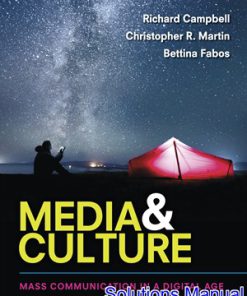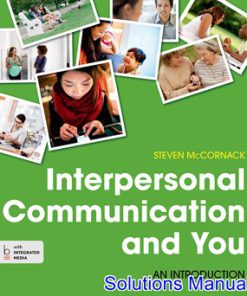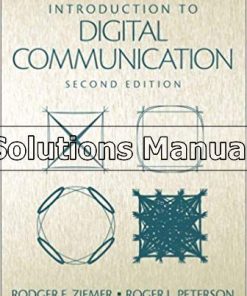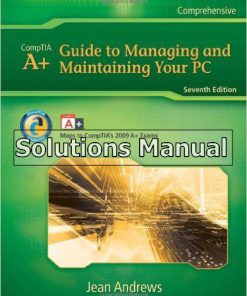Choices and Connections An Introduction to Communication 2nd Edition McCornack Solutions Manual
$26.50$50.00 (-47%)
Choices and Connections An Introduction to Communication 2nd Edition McCornack Solutions Manual.
You may also like
Choices and Connections An Introduction to Communication 2nd Edition McCornack Solutions Manual
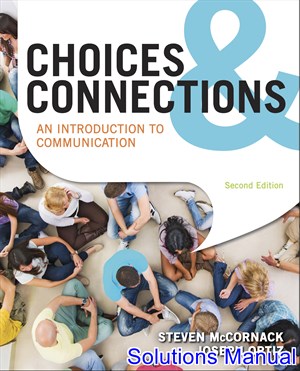
Product details:
- ISBN-10 : 1319043526
- ISBN-13 : 978-1319043520
- Author: Steven McCornack
Based on decades of teaching experience combined with the latest in research and communication theory, Steve McCornack and Joseph Ortiz’s Choices & Connections, 2e helps students to transform their lives and become more adaptive and versatile communicators. With a focus on the connections that underlie all communication choices—and that the outcomes students experience are deeply connected to the communication choices they make—Choices & Connections, 2e weaves together major communication contexts so that students’ understanding becomes cohesive. Captivating students from page one, the text is highlighted by built-in study tools, innovative video case study activities, and a variety of news, pop culture, and real-life examples—all of which encourage students to apply what they learn to their own their daily communication experiences.
Table contents:
Part 1: Communication Foundations
Chapter 1: Introduction to Communication
What Is Communication?
Defining Communication
Why We Communicate
Communication Models
Studying Communication
A Brief History of Communication
Types of Communication
Communication Competence
Understanding Communication Competence
Putting Competence into Practice
Choices and Connections
Communication Skills
Advance the Conversation: Phubbing Your Partner
Communication Connections
Advance the Conversation Take Two: Competent Conversations
Chapter 1 Review
Chapter 2: Self and Perception
The Nature of Self
Self-Awareness
Self-Concept
Self-Esteem
Gender, Sexual Orientation, Culture, and Self
Presenting Self
Creating Faces and Masks
Losing Face
Maintaining Face
Advance the Conversation: Distorting Online Self-Presentation
Perceiving Others
The Perception Process
Perception and Culture
Attributions and Perceptual Errors
Forming Impressions
Gestalts
Algebraic Impressions
Stereotypes
Improving Perception
Perception-Checking
Empathy
Advance the Conversation Take Two: Empathy for a Group Member
Chapter Review
Chapter 3: Understanding Gender and Culture
What Is Gender?
Gender Defined
Gender and Communication
Gender and Verbal Communication
Gender and Nonverbal Communication
Moving Beyond Gender Stereotypes
Advance the Conversation: Challenging Binary Judgments
What Is Culture?
Culture Defined
Co-Cultures
Intersections of Identity
Prejudice
Culture and Communication
Dimensions of Difference
Communication Accommodation
Creating Intercultural Competence
World-Mindedness
Attributional Complexity
Advance the Conversation Take Two: Confronting Cultural Stereotypes and Communicating More Competently
Chapter Review
Chapter 4: Mediated Communication
What Is Mediated Communication?
Types of Mediated Communication
Functions of Mediated Communication
Characteristics of Mediated Communication
Self-Presentation and Mediated Communication
Creating Online Face
Managing Online Face
Mediated Communication Challenges
Perceived Social Isolation
Online Disinhibition
Digital Deception
Using Mediated Communication Competently
Advance the Conversation: Friends Don’t Let Friends Fight on Social Media
Advance the Conversation Take Two: Removing an Embarrassing Post
Chapter Review
Chapter 5: Verbal Communication
The Nature of Verbal Communication
Language Is Symbolic
Language Is Governed by Rules
Language Conveys Meaning
Language and Culture Are Intertwined
Verbal Communication Skills
Create Understandable Messages
Use “I” and “We” Language
Avoid Gender-Based Presumptions
Be Mindful of Cultural Differences
Verbal Communication Challenges
Prejudiced Language
Verbal Aggression
Deception
Advance the Conversation: Protecting a Friend from Harm
Defamation
Advance the Conversation Take Two: Disagreement with Family
Chapter Review
Chapter 6: Nonverbal Communication
Characteristics of Nonverbal Communication
Nonverbal Communication Uses Multiple Channels
Nonverbal Communication Conveys More Meaning Than Verbal Communication
Nonverbal Communication Blends with Verbal Communication
Nonverbal Communication Is Influenced by Gender
Nonverbal Communication Is Influenced by Culture
Types of Nonverbal Communication
Body Movement
Voice
Touch
Personal Space
Appearance
Environmental Features
Functions of Nonverbal Communication
Conveying Meaning
Expressing Emotion
Presenting Self
Managing Interactions
Advance the Conversation: I Wasn’t Being Sarcastic!
Defining Intimacy
Strengthening Your Nonverbal Communication Skills
Enhancing Your Nonverbal Expressiveness
Inhibiting Your Nonverbal Behaviors
Checking Your Nonverbal Attributions
Advance the Conversation Take Two: Perceiving Nonverbal Messages
Chapter Review
Chapter 7: Active Listening
The Listening Process
Stages of the Listening Process
Motives for Listening
Multitasking and Listening
Advance the Conversation: To Multitask or Not, That Is the Question!
Listening Styles
Four Listening Styles
Gender and Listening Styles
Culture and Listening Styles
Barriers to Active Listening
Selective Listening
Pseudo-Listening
Aggressive Listening
Improving Active Listening Skills
Manage Your Feedback
Adapt Listening
Recognize the Value of Silence
Advance the Conversation Take Two: Active Listening
Chapter Review
Part 2: Interpersonal Communication
Chapter 8: Principles of Interpersonal Communication
What Is Interpersonal Communication?
Interpersonal Communication Is Transactional
Interpersonal Communication Is Dynamic
Interpersonal Communication Is Relational
Interpersonal Communication Is Impactful
Why Form Relationships?
Proximity
Resources
Similarity
Reciprocal Liking
Physical Attractiveness
Types of Relationships
Romantic Relationships
Family Relationships
Friendships
Advance the Conversation: When a Good Friend Changes
Workplace Relationships
Relationship Stages
Coming Together
Coming Apart
Advance the Conversation Take Two: Ending a Relationship
Chapter Review
Chapter 9: Managing Interpersonal Relationships
Self-Disclosure in Relationships
Self-Disclosure and Relationship Development
Communicating Self-Disclosure
Self-Disclosure Skills
Advance the Conversation: I Don’t Want to Hear This!
Managing Relationship Tensions
Openness versus Protection
Autonomy versus Connection
Novelty versus Predictability
Sustaining Your Relationships
Relational Maintenance
Supportive Communication
Advance the Conversation Take Two: Relationship Maintenance at Work
Chapter Review
Chapter 10: Managing Conflict
Defining Conflict
Conflict Begins with Perception
Conflict Involves Clashes between Goals or Actions
Conflict Is a Process
Selecting an Approach to Conflict
Avoidance
Accommodation
Competition
Advance the Conversation: I Didn’t Lie!
Collaboration
Conflict Endings
Separation
Domination
Compromise
Integrative Agreements
Structural Improvements
Barriers to Constructive Conflict
Attributional Errors
Destructive Messages
Cultural Differences
Advance the Conversation Take Two: Conflict with a Roommate
Chapter Review
Part 3: Small Group Communication
Chapter 11: Small Group Communication
Defining Small Groups
Characteristics of Small Groups
Types of Small Groups
Development of Small Groups
How Small Groups Communicate
Balancing Group Roles
Building Cohesion
Establishing Positive Norms
Sharing Responsibility
The Self’s Influence on Small Group Communication
Communication Traits
Gender
Culture
Advance the Conversation: You’re Not Funny
Virtuality and Small Groups
Benefits and Challenges of Group Virtuality
Improving the Quality of Virtual Group Meetings
Advance the Conversation Take Two: Conflict with a Group Member
Chapter Review
Chapter 12: Leadership in Group Communication
Perspectives on Leadership
Traits View
Style View
Situational View
Functional View
Leading with Communication
Supporting Diversity, Equity, and Inclusion
Creating a Communication Climate
Preventing Groupthink
Dealing with Conflict
Advance the Conversation: The Bearer of Bad News
Leading Problem Solving
Structured Problem Solving
Group Brainstorming
Leading Decision Making
Decision by Authority
Decision by Vote
Decision by Consensus
Leading Meetings
Planning Meetings
Conducting Meetings
Following Up On/Evaluating Meetings
Advance the Conversation Take Two: Handling Complaints
Chapter Review
Part 4: Public Communication
Chapter 13: Preparing Your Speech
Preparing a Speech: First Steps
Choosing a Speech Topic
Identifying the General Purpose
Considering Speech Topics
Deciding on a Topic
Analyzing an Audience
Understanding an Audience
Developing an Audience Analysis
Advance the Conversation: Speaking Your Mind
Writing a Specific Purpose Statement
Planning a Research Strategy
Identifying Information Needs
Drawing on Personal Knowledge
Talking with Librarians
Documenting Research Findings
Conducting Research
Primary and Secondary Resources
Internet Resources
Library Resources
Interpersonal Resources
Evaluating Your Resources
Advance the Conversation Take Two: Oral Citations
Chapter Review
Chapter 14: Composing Your Speech
Developing a Speech Thesis
Identifying and Supporting Main Points
Identifying Main Points
Supporting Main Points
Organizing a Speech
Selecting an Organizational Pattern
Using Connectives
Keeping Listeners Engaged
Advance the Conversation: But the Video Went Viral!
Introducing and Concluding a Speech
Introducing a Speech
Concluding a Speech
Putting It All Together: Speech Outlines
Preparation Outline
Delivery Outline
Advance the Conversation Take Two: Elevator Speeches
Sample Preparation and Delivery Outlines
Preparation Outline
Delivery Outline
Chapter Review
Chapter 15: Delivering Your Speech
Speech Delivery Modes
Impromptu Speaking
Manuscript Speaking
Extemporaneous Speaking
Maximizing Speech Delivery
Conveying Immediacy
Projecting Confidence and Competence
Managing Delivery in Online Speeches
Managing Speech Anxiety
Advance the Conversation: Helping a Friend Manage Speech Anxiety
Choosing and Using Presentation Aids
Types of Presentational Aids
Presentation Software
Tips for Using Presentational Aids
Evaluating Speeches and Managing Feedback
Giving Effective Feedback
Using Feedback to Improve Speech Performance
Advance the Conversation Take Two: Delivering a Speech
Chapter Review
Chapter 16: Informative Speaking
What Is Informative Speaking?
Functions of Informative Speeches
Specific Purposes for Informative Speeches
Informative versus Persuasive Speaking
Types of Informative Speeches
Expository Presentations
Process or Demonstration Presentations
Narrative Presentations
Comparison/Contrast Presentations
Guidelines for Informative Speaking
Choose a Personally Involving Topic
Capture—and Hold—Listeners’ Attention
Advance the Conversation: Some Things Are Better Left Unsaid
Use Conversational Language
Make the Speech Content Understandable
Help Audiences Remember the Message
Advance the Conversation Take Two: Responding to Audience Questions
Sample Informative Speech: Going Carbon Neutral on Campus
Chapter Review
Chapter 17: Persuasive Speaking
What Is Persuasive Speaking?
Types of Persuasive Propositions
Audience Analysis for Persuasive Speeches
Credibility in Persuasive Speeches
Organizing and Supporting Persuasive Speeches
Organizing Persuasive Speeches
Advance the Conversation: Do or Die: Using Scare Tactics to Persuade Others
Reasoning for Persuasive Speeches
Avoiding Fallacies
Appealing to Your Audience’s Needs and Emotions
Connecting to Audience’s Needs
Providing Testimony and Stories
Using Descriptive Language
Guidelines for Persuasive Speaking
Establish Goodwill with Your Audience
Keep Your Specific Purpose Realistic
Decide How to Present an Issue
Maintain High Ethical Standards
Advance the Conversation Take Two: Emotional Appeals
Sample Persuasive Speech: Becoming a Socially Conscious Consumer
Chapter Review
Appendix: Interviewing
What Is Interviewing?
Types of Interviews
Preparing for an Interview
Essential Communication Skills for Interviewing
Being an Active Listener
Building Rapport and Demonstrating Cooperation
Using Mediated Communication during Interviews
Information Interviewing
Preparing for an Information Interview
Managing an Information Interview
Employment and Admissions Selection Interviewing
Preparing for Selection Interviews
Advance the Conversation: Well… to Be Totally Honest With You
Managing a Selection Interview
Advance the Conversation Take Two: Managing Stress Questions
Appendix Review
Glossary
References
Index
Pop Quiz Answers
People also search:
choices and connections an introduction to communication pdf
choices and connections an introduction to communication
choices and connections an introduction to communication 3rd edition pdf
choices and connections an introduction to communication 2nd

